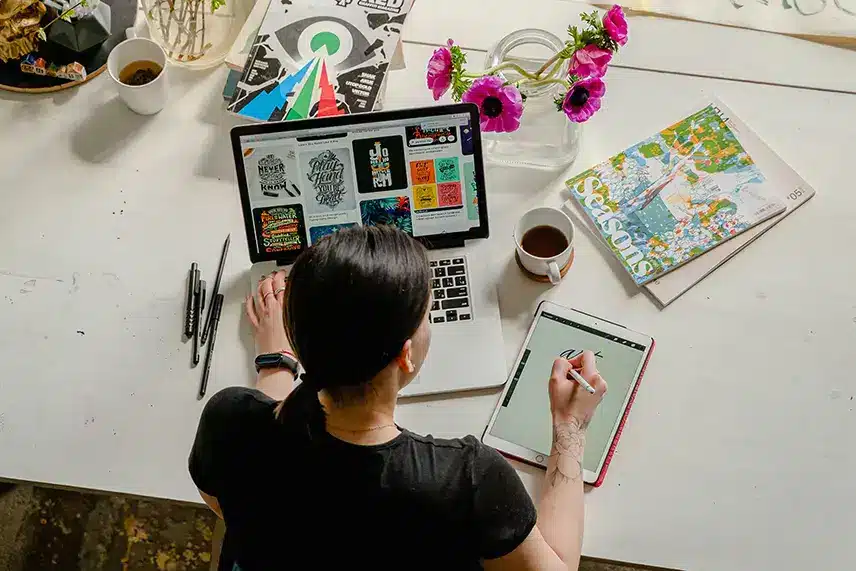Key Takeaways:
- Graphic design involves visual communication: It combines art and technology to create visual elements and solve problems using typography, imagery, color, and space. The American Institute of Graphic Arts (AIGA) defines graphic design as the art and practice of planning and projecting ideas and experiences with visual and textual content.
- Graphic design plays a crucial role in communication: It is integral to advertising, marketing, and branding. Effective design helps businesses and organizations communicate their message to their target audience and differentiate themselves from the competition.
- There are various types of graphic design: Traditional print-related graphic design includes logos, brochures, posters, and packaging. Emerging types of graphic design include website design, user experience (UX) design, and motion graphics design. As demand shifts towards digital graphics and imagery, the most common job titles include graphic designer, UX designer, web designer, art director, and creative director.

What is graphic design?
As I delve into the world of design, I can’t help but wonder – what exactly is graphic design? According to the American Institute of Graphic Arts (AIGA), it is a collaborative process of problem-solving. But what exactly does that mean?
Defining graphic design according to American Institute of Graphic Arts
Graphic design is the art of creating visual content that can communicate messages effectively. As per the American Institute for Graphic Arts (AIGA), graphic design deals with all things related to visual communication that include typography, visuals and color among other things. It plays a significant role in communication, making content clear and understandable to its intended audience.
The basics incorporate elements such as color, form, line, shape, size, space, and texture while using principles like balance, contrast and proportion to ensure a smooth flow in the design. The emergence of digital technology has expanded the field from traditional print-related examples to website design, user experience (UX) design and motion graphics design.
The rise in demand for digital imagery and graphics has created new opportunities for graphic designers with job titles including UX or web designer; art director; creative director; and more. Sketchbooks are an essential tool in any designer’s process while computer software like Adobe Illustrator, Photoshop or XD play significant roles in executing complex projects.
Though many claims have risen concerning who invented Graphic Design as we know it today- there exist various notable designers who played pivotal roles shaping how we see it now.
Importance of graphic design in communication
Graphic design plays a crucial role in conveying messages effectively through visual means, making it an essential component of modern communication. By using a wide range of creative approaches such as color, form, line, shape, size, space and texture – graphic design offers designers the ability to create compelling visuals that resonate with their intended audience. Whether it’s designing print materials like posters or business cards, creating innovative web or mobile user interfaces or crafting engaging motion graphics for animation projects – graphic design is key to visually communicating ideas and concepts across all mediums.
Furthermore, the significance of design principles like balance, contrast and proportion cannot be overstated. Employing these techniques helps to guide the viewer’s eye through designs in an intuitive way thereby ensuring maximum impact with minimum clutter. The result is a harmonious layout that reinforces brand messaging and makes information easy to consume.
In addition to traditional print-related design work like packaging and branding – emerging areas of focus such as website design, user experience (UX) design and motion graphics design are becoming increasingly important. These new domains bring fresh challenges for designers who must adapt to different technologies and mediums while keeping designs visually appealing.
Color, form, line, shape, size, space, and texture – the building blocks of graphic design basics that make all the difference.
"Design is intelligence made visible."
Alina Wheeler, author
GRAPHIC DESIGN BASICS
As I delve deeper into the world of graphic design, I realize the significance of understanding its basics. One of the crucial aspects is mastering its elements and principles. In this segment, I will explore the fundamental elements, which include color, form, line, shape, size, space, and texture. Each of these elements plays a specific role in creating compelling visual graphics. Furthermore, I will delve into the principles of graphic design that focus on the intricate aspects of the composition, such as balance, contrast, emphasis, movement, proportion, and rhythm. Understanding these critical aspects of graphic design will help me create visually appealing and effective graphics.
Elements of graphic design: color, form, line, shape, size, space, texture
Graphic design comprises various crucial elements that are essential to create effective designs. These elements enable designers to create visually appealing designs that engage the audience. The combination of these components results in the creation of a captivating design.
The crucial elements are:
- Color: Colors are a vital aspect of graphic design, as they evoke emotions and moods, making it an important tool for designers.
- Form: Form refers to the three-dimensional aspect of design and its physical structure, which impacts how users interact with objects.
- Line: Lines play a vital role in graphic design as they help in creating shapes, patterns, textures, and depth.
- Shape: Shapes are created from lines and curves and play a critical role in all visual communication forms used by designers.
- Space: Space is an essential element of any graphic design layout and affects how contents are arranged. Creating white spaces helps draw attention to specific elements.
- Size: The size of different elements within a design gives importance to certain items over others by controlling flow and visual impact.
- Texture: Texture plays an integral part in helping achieve balance within a graphic design layout.
Understanding these elements will help designers make informed decisions when developing their ideas while combining these various aspects to craft an effective and visually appealing design. Moreover, knowing what each element can achieve will help the designer determine which areas may need more effort or where more concentration should be focused. This approach heavily influences how much time is allocated when trying to convey a certain message through designing.
To create exceptional designs using these elements, one must ensure that:
- The right colors cater to the message being delivered.
- Forms designed should accurately represent what they signify without causing confusion.
- Lines must be consistent across the whole figure or print.
- Shapes need to be straightforward while complementing other graphics in proximity.
- White spaces must be balanced across entire spacing rather than around blockings or figures.
- Sizes have to precisely highlight every item’s worth proportionally.
- Textures have opportunities beyond just visual perception to add more depth and richness to the design.
Therefore, designers must consider these elements extensively while developing their designs, ensuring perfect balance for components being fitted into layouts with proper effectual space. Graphic design principles are like a dance: balance, contrast, emphasis, movement, proportion, and rhythm all work together to create a beautiful composition.
Principles of graphic design: balance, contrast, emphasis, movement, proportion, rhythm
Principles of graphic design involve numerous aspects such as layouts, typography, color theory, and imagery to create appealing designs. Understanding the principles helps in conveying a message to the audience effectively.
- Balance: Refers to visual equilibrium and the distribution of elements. Achieving balance results in an aesthetically pleasing design.
- Contrast: The difference between elements in a design bringing attention to specific elements.
- Emphasis: Emphasizing a particular design element by manipulating its size, color or placement highlights its importance.
- Movement: Leads viewers’ eyes across a design using various techniques like directional cues or images that create an illusion of motion.
- Proportion: Concerns with the size relationship between different elements within a design.
- Rhythm: Creates movement by repeating similar types of shapes or colors throughout a composition to build consistency.
Graphic designers should ensure their designs follow these principles for optimal impact on users. With this knowledge, efficient visual communication is made possible.
To make designing successful; cultivating adaptability, keeping up with current trends and technology advances, making round files saved often while sticking to the brief will help in ensuring quality finished graphics.
From paper to pixels, graphic design has evolved into traditional print-related projects and emerging digital designs such as website and motion graphics.
TYPES OF GRAPHIC DESIGN
As a graphic designer, I’ve always been fascinated by the wide range of applications for my craft. In this discussion, we’ll take a closer look at the different types of graphic design and the exciting possibilities within each field. First, we’ll explore traditional print-related graphic design examples – think magazines, newspapers, and billboards. Then, we’ll delve into the emerging types of graphic design, such as website design, user experience (UX) design, and motion graphics design.
Traditional print-related graphic design examples
Graphic design has been around for centuries and has evolved along with technology, from traditional print-related graphic design examples to emerging types like website and UX design. The former category relates to the design of materials that are printed, such as brochures, billboards, and business cards.
Traditional print-related graphic design examples usually involve creating visual content intended for paper or other physical media. This could include designing logos, illustrations, packaging materials, and book layouts. Traditional designers are skilled in techniques such as typography, color theory, and layout planning.
Designers proficient in traditional print-related graphic design serve an important role in marketing campaigns by crafting visually appealing materials for their clients with the right colors and images that match their branding.
One suggestion some designers use is to ensure a strong visual hierarchy so that readers can easily scan through different elements on a page or display while conveying a clear message. Additionally, using images strategically helps capture attention and draw people in while giving the text context.
Emerging types of graphic design: website design, user experience design, motion graphics design
Graphic design has evolved over the years, bringing forth new forms in recent times. The emergence of new forms in graphic design includes website design, user experience (UX) design, and motion graphics design. These emerging types focus on enhancing the user experience by improving usability and interaction with products.
- Website Design: This form of graphic design focuses on designing and creating visually appealing websites that provide effortless navigation to users.
- User Experience (UX) Design: UX designers create designs using digital tools to enhance user satisfaction by improving usability and accessibility.
- Motion Graphics Design: Motion designers bring graphics to life through animation and video production that visually stimulate users.
The principles behind each emerging form differ slightly as they cater to different aspects of communication. Website designs focus on ease of navigation while motion graphics aim for visual storytelling. This makes each type essential in their unique contribution towards communication through graphic design.
It is crucial for emerging graphic designers to have skills relevant to these forms as more companies are shifting online. Thus, there is an ever-growing demand for professionals who can incorporate these emerging types of graphic design in web development or product marketing.
To ensure their success as a modern-day graphic designer, it is recommended that they stay current with emerging trends such as these forms mentioned above. Incorporating these skills increases their employability.
Why settle for just designing graphics when you can be a graphic designer, UX designer, web designer, art director, or creative director?
COMMON GRAPHIC DESIGN JOBS
As a graphic designer, I’ve seen firsthand how the industry has evolved over the years. Clients are looking for more than just traditional print design – they want to establish a digital presence too. In this segment, we’ll focus on the shift in demand for digital graphics and imagery. This has led to a rise in demand for various graphic design job titles. We’ll take a closer look at some of the most common ones, including the graphic designer, UX designer, web designer, art director, and creative director.
Shift in demand for digital graphics and imagery
The rise of digital media has brought about a significant shift in demand for visual content. This shift in demand has resulted in an increasing need for digital graphics and imagery. As technology advances, design professionals are expected to create engaging and interactive designs that cater to a growing online audience.
With the advent of social media platforms, graphic design has become an integral part of content creation. Users expect visually appealing designs whenever they access online content. As such, graphic designers have had to adjust their skills to meet this growing demand by creating digital graphics and imagery for websites and social media platforms.
In addition to traditional print graphic design jobs, there is now a surge in demand for new types of graphic design roles such as website designers, user experience (UX) designers, and motion graphics designers. These new types of job roles have arisen due to the need for compelling designs across various digital mediums.
To keep up with these changes, it is imperative that design professionals stay up-to-date with the latest software tools and industry trends. Using software such as Adobe Photoshop or Adobe Illustrator can help designers create stunning visuals that are both aesthetically pleasing and engaging.
From design novice to creative director, the world of graphic design offers a myriad of job titles to fit every skill set.
Most common graphic design job titles: graphic designer, UX designer, web designer, art director, creative director
Graphic design industry has a wide range of job titles, including the most common job titles: graphic designer, UX designer, web designer, art director, creative director. Here are some noteworthy details about these job titles.
- Graphic Designer – This job requires creativity and good communication skills to interpret client needs and convey them through visuals.
- UX Designer – Focused on designing interfaces that enable the user to interact with a product naturally within a digital environment.
- Web Designer – Developing websites using layout, color schemes and font types to build visually appealing pages.
- Art Director / Creative Director – These senior-level positions call for managing a team of designers or artists to create visual content that meets the client’s briefs.
In addition to these traditional roles, there is now an increasing demand for digital graphics and imagery in areas such as website design, user experience (UX) design & motion graphics design.
For those interested in pursuing one of these positions, it’s important to gain experience in various software applications such as Adobe Suite (Photoshop, Illustrator, InDesign), SketchUp 3D modeling software, HTML/CSS/JavaScript programming languages and more. Networking within the industry and developing a strong portfolio is also essential to success.
From sketchbooks to software, these popular graphic design tools will elevate your creative game.
POPULAR GRAPHIC DESIGN TOOLS
As a graphic designer, my tools are an extension of my creativity. Choosing the right tools to convey a message through visuals can sometimes be a challenge. These tools help me craft meaningful content for my clients.
First, we’ll discover the importance of a sketchbook in the design process. The second tool we’ll explore are the essential computer software applications for graphic design projects. Together, these tools provide a comprehensive approach to accomplishing design goals with efficiency and innovation.
Importance of sketchbook in the design process
One crucial aspect in the creative process is the use of sketchbooks to generate, develop and refine ideas. Sketchbooks can be utilized to visualise design concepts, experiment with layouts and typography, and test out color combinations. The importance of sketchbook in the design process is significant as it serves as a tool for brainstorming.
In addition to brainstorming, keeping a sketchbook can also help designers to stay organized and keep track of progress on projects over time. It allows them to reflect on their designs retrospectively, compare earlier versions with newer ones, and make revisions while keeping all iterations preserved.
Unlike digital tools that may require power or portability, sketchbooks are lightweight and easily accessible wherever and whenever inspiration strikes. Designers often carry one everywhere they go, as they know that ideas can come at any time.
Historically speaking, artists have always used sketchbooks as a way of recording ideas[*], but their usefulness is not limited only to artists; designers have been relying on them for decades now. By allowing creative ideas to flow freely outside of a screen interface or software program limits, a designer’s creativity knows no bounds.
[*]Ludwig Amadeus Probstl (sketch artist) said “It’s like an internal conversation makes it easier for me later on in the work phase.”
Essential resources and tools for graphic design projects
Graphic design projects require specific software to create and edit images and designs digitally. Below are some of the essentials:
- Adobe Photoshop – a powerful image editing software that allows designers to manipulate photos, graphics, and digital images
- Illustrator – a vector graphics editor used to create scalable illustrations, logos, typography, and complex designs
- InDesign – a desktop publishing software that allows designers to create print layouts such as brochures, magazines, flyers, and books
- Sketch – a digital design tool specifically for UX/UI designers that enables them to create wireframes, prototypes, interface designs
- Adobe XD – a powerful design and prototyping tool that streamlines the creation of user interfaces and experiences for websites, mobile apps, and more.
- Figma – a collaborative design tool that enables teams to create, prototype, and iterate on digital designs in real-time, all within a browser-based environment.
- Affinity Designer – an alternative vector graphics editor with similar features as Adobe Illustrator
- Cinema 4D – a professional-grade program used in motion graphics design and animation.
- Stock photography – refers to a collection of pre-shot images that can be licensed for various purposes, such as advertising, marketing, or design, by individuals or businesses. Some example sites include iStock, Pexels and Pixabay.
- Fonts – are the visual representation of text, including different styles, weights, and variations, used to enhance the aesthetics and communication of written content. Graphic designers use fonts to enhance the visual appeal, readability, and communication of written content by selecting appropriate typefaces, styles, sizes, and arrangements to convey the desired tone, mood, and message in various design projects such as logos, advertisements, websites, and print materials.
- Color palettes – curated collections of colors that we use to create harmonious and visually appealing combinations in designs, ensuring consistency and aesthetic balance across various elements. Some online color palette tools include: mycolor.space, paletton.com, and contrast checker for accessibility.
Using these tools enhances designers’ creativity with digital illustrations and graphic design pieces.
It’s recommended for graphic designers to expand their knowledge by frequently studying other programs. These additional skills can allow creatives more flexibility within their work.
Pro Tip: Familiarize yourself with essential plugins and keyboard shortcuts of the above-highlighted software to accomplish tasks faster.
"Accessible design is good design."
Steve Ballmer, Former CEO of Microsoft






